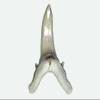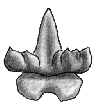| |
INTRODUCTION
Unable to locate a good reference for Sharktooth Hill material, the two authors
decided a webpage might prove helpful in gathering and sharing information on
this site. We solicit suggestions, comments, criticism and new information to
include in this page. The objective is to provide a list of the available shark
and ray species, and provide illustrations or images that will assist in the
identification of this material. We would like to thank the
Buena Vista Museum of Natural History
for much of the preliminary information included below.
STRATIGRAPHY AND DEPOSITIONAL ENVIRONMENT
The formation that includes "Sharktooth Hill" is locally refered to by geologists
as the "Round Mountain Silt Formation". Located in Kern County, California, it was
deposited by a river delta coming out of the mountains to the east of Bakersfield. At
this time (Middle Miocene ) most of central California was covered by a small sea. As
time progressed the central California region dried up exposing the Miocene and Early
Pliocene deposits. The Southern Bakersfield region continued to exist as a swampy area
well into the Pleistocene. At the same time the Miocene deposits eroded into a hilly
area with many gullies exposing the so-called "Upper Layer of the Round Mountain Silt
Formation". This is the layer containing most of the bone beds which have yielded the
most diverse and best studied Tertiary fossil marine vetebrate
assemblage yet known from anywhere within the Pacific Realm.
This fossil assemblage, called the Sharktooth Hill Local Fauna (Wood et al., 1941), is
comprised of more than one hundered species of sharks, rays, bony fish, turtles, birds
and mammals, including terrestrial species from the adjacent Miocene land mass (south
of where Bakersfield currently is located). The "Round Mountain Silt Formation" covers
approximately 110 square miles. The Sharktooth Hill Bonebed is a single, relatively thin,
but widespread horizon -- this fossil producing layer is only 6-18" thick (with some
exceptions). It has been correlated with the Barstovian North American Land Mammal Age,
and is approximately 13 and 15 million years old.
CHONDRICHTHYAN FAUNA
The species list we obtained from the Buena Vista Museum (BVMNH)
included certain species that were unfamiliar to us, and descriptions have not yet been
located. Comments regarding these tentative identifications will be noted in the text
of our cyber-list. If fossil teeth have been previously illustrated in other sections
of the website, links will be directed to that material, otherwise, Sharktooth Hill
material will be employed. The below shark faunal list incorporates the observations
and help of Steve Alter, Bill Heim, Gordon Hubbell, Walter Hunt and Hideo Yabe.
 CLICK ON IMAGES FOR ADDITIONAL DETAILS
CLICK ON IMAGES FOR ADDITIONAL DETAILS
unless accompanied by "not linked" icon.
|
| HEXANCHIFORMES |
| | | |
 |
Hexanchus andersoni JORDAN, 1907
Extinct Sixgilled shark. |
 |
Notorynchus sp - Sevengill shark.
Unlike the Lee Creek fauna,
Notorynchus is the "tough" cow shark in Bakersfield. |
| SQUALIFORMES |
 |
Enchinorhinus blakei AGASSIZ, 1856
Bramble shark
A scarce species from Bakersfield, CA, The accommpanying tooth is only
1.5 cm wide x 1cm high |
 |
Squalus serriculus JORDAN & HANNIBAL 1923
Dogshark |
| SQUATINFORMES |
 |
Squatina lericheii JORDAN & BEAL, 1913
Angel shark |
| HETERODONTIFORMES |
 |
Heterodontus -- Bullhead shark The illustrated tooth is 3.0 mm in height.
Based on studied material, these teeth are relatively common and are easily confused with
male dasyatid teeth or are thought to be from skates, unless observed under magnification. |
| LAMNIFORMES |
 |
Carcharias cuspidata (AGASSIZ, 1843)
extinct Sand Tiger shark.
(Image of a Lee Creek specimen) |
 |
?Megachasma sp - Megamouth shark.
Known from Pyramid Hill with reports of Sharktooth Hill. West coast teeth ascribed
to this genus are significantly different from Lee Creek specimens and the extant
species. Likely a different genus. |
 |
Alopias ?latidens (LERICHE 1909)
extinct Thresher shark
|
 |
Cetorhinus cf maximus (GUNNER 1765)
Basking shark
This particular tooth, provided by Steve Alter
is 7,0 mm in height. Another of his specimens was only 4.5 mm in height. |
 |
Carcharocles chubutensis (AMEGHINO, 1906)
extinct Mega-toothed shark
from Early Miocene exposures. |
 |
Carcharocles megalodon (AGASSIZ, 1837)
extinct Mega-toothed shark.
The largest and best known fossil shark teeth come from this huge predator. Jordan (1907)
deemed the California teeth to be different from their right coast counterparts, and ascribed them to a new
species -- Carcharodon branneri. In 1913, Jordan reassigned these teeth to Carcharodon megalodon. |
 |
Cosmopolitodus (Isurus) planus (AGASSIZ, 1856)
extinct Great White shark |
 |
Cosmopolitodus (Isurus) hastalis (AGASSIZ, 1843)
extinct Great White shark
Teeth from this species often characterized by the broad
flat labial root face. |
 |
Cosmopolitodus (Isurus) sp
extinct Great White shark
Teeth similar to C. escheri and
serrate Peruvian teeth. |
 |
Carcharodon sp - Great White shark
It is commonly assumed that the serrate lamnid teeth from Sharktooth Hill came from
Carcharodon carcharias (LINNAEUS, 1758).
Jordan saw more than one species in the fauna.
He assigned teeth to C. rectus Agassiz ["perhaps
nearer than any others here named to the living man-eating shark, C. carcharias"]
but later (1913) noting that they might be C. megalodon with a lateral denticles.
(Sounds like juvenile Carcharocles megalodon.).
Another, he named C. arnoldi [noting, "serrae rather smaller and more numerous" than
C. riversi] then resisted Leriche's attempt to shoe-horn this tooth into
C. carcharias. (Sounds like the serrate Cosmopolitodus hastalis).
A third he named C. riversi ["denticles fewer and coarser than in any other species".];
Sounds like Carcharodon carcharias.
there are other opinions. . . . . |
 |
Isurus oxyrinchus RAFINESQUE, 1809
aka I. desori (SISMONDA, 1849)
Shortfin Mako shark
|
 |
Isurus retroflexus (AGASSIZ, 1843)
aka I. paucus GUITART MANDAY, 1966
Longfin Mako shark
|
 |
Parotodus benedeni (LeHON, 1871)
extinct False Mako shark.
Teeth from this species are very uncommon. |
| CARCHARHINIFORMES |
SPECIMEN
REQUIRED |
Cephaloscyllium -- Swellshark.
This catshark is listed by the
BVMNH as present in the fauna. An illustration or representive example of
this tooth design has not been seen. |
 |
cf Scyliorhinus -- Catshark.
This specimen,
from the collection of Gordon Hubbel, is the only catshark tooth-design seen from
Sharktooth Hill, and it is very similar to Scyliorhinus teeth from Lee
Creek. This may be the design that served as the basis of the Cephaloscyllium
identification above. It should be noted that C. ventriosum
(GARMAN, 1880), the extant catshark species of California waters, has a less
robust tooth design, however, this tooth does compare rather well with an illustration of
C. sufflans (REGAN, 1921), an extant Red Sea species. |
 |
Galeorhinus sp - Tope shark.
Not included in the BVMNH faunal list. Jordan & Beal (1913) describe
a new species, G. hannibaldi from the Miocene and Pliocene. Illustrated specimen
from Lee Creek. |
 |
Triakis beali JORDAN, 1919.
This species was included in the BVMNH faunal list but illustrations
have not been seen. The depicted (Gordon Hubbel) specimen initially
struck me as being catshark-like, but it is more similar to the extant species
Triakis scyllium MÜLLER & HENLE, 1839 |
SPECIMEN
REQUIRED |
Mustelus -- Smooth-hound shark
BVMNH faunal list, illustration not seen. |
 |
Hemipristis serra AGASSIZ, 1843
Snaggletooth shark.
Snaggletooth teeth from this site were originally assigned to H. heteropleurus Agassiz
and H. chiconis Jordan (1907). |
GOOD
LUCK |
Carcharhinus antiquus (AGASSIZ, 1856)
This species was included in the BVMNH faunal list, but the
illustration in Jordan (1907) was of poor quality and the tooth damaged. Jordan (1907)
had originally identified this tooth as Agassiz's Prionodon antiquus but placed
it in the genus Carcharias and in 1913, moved it to Carcharhinus but
speculated it might be Carcharodon, possibly C. rectus. |
 |
Carcharhinus cf egertoni (AGASSIZ, 1843)
extinct requiem shark.
BVMNH faunal list, illustration not seen. |
 |
Carcharhinus cf limbatus (VALENCIENNES, 1839)
Blacktip shark |
 |
Carcharhinus obscurus (LeSUEUR, 1818)
Dusky shark |
 |
Galeocerdo aduncus (AGASSIZ, 1843)
extinct Tiger shark
Jordan (1907) followed Agassiz and attributed these teeth to
G. productus AGASSIZ, 1853. Leriche subsequently indicated that
they were identical to G. aduncas but Jordan (1913) rejected this notion based on
geographic considerations. |
 |
Galeocerdo contortus GIBBES, 1849
extinct Tiger shark. The illustrated specimen measures 15.0 mm in height. |
 |
 Sphyrna cf zygaena (LINNAEUS, 1758) —
Hammerhead shark
Sphyrna cf zygaena (LINNAEUS, 1758) —
Hammerhead shark
These teeth have been reported as Sphyrna ?laevissima
|
| RAJIFORMES |
SPECIMEN
REQUIRED |
Rhinobatos sp - Guitarfish.
Reported from the fauna, no example available to authors. |
see: the genus
Rhinobatos |
SPECIMEN
REQUIRED |
Raja sp - Skate. If skate teeth are in this fauna,
they must be pretty rare. I've viewed a couple thousand Sharktooth Hill batoid teeth
and haven't seen a skate tooth yet. |
| MYLIOBATIFORMES |
TO BE
DRAWN |
Dasyatis spp - Stingray. There appears to be three common
stingrays in this fauna. |
see: the genus
Dasyatis |
EXAMPLE
REQUIRED |
Gymnura sp - Butterfly Rays. I haven't seen any teeth
which I'd ascribe to this genus. The fauna does yield male devil ray teeth which are
similar to the gymnurid tooth-design. |
 |
Mobula loupianensis CAPPETTA, 1970 -- extinct devil ray.
The illustrated male tooth is 2 mm high. These teeth are only 1/10th as common as those
from stingrays, but are still common within the fauna. |
EXAMPLE
REQUIRED |
Myliobatis merriami JORDAN & BEAL, 1913.
Looking over myliobatid material, there appears to be at least one Myliobatis
species, and another genus more reminiscent of Aetomylaeus. A third myliobatid
may also be present. Refering to the 1913 illustration, this tooth-design may be the one
that is reminiscent of the Aetomylaeus design. |
EXAMPLE
REQUIRED |
Myliobatis smithii (JORDAN & BEAL, 1913)
These teeth were originally placed in Rhinoptera by Jordan and Beal; who
reassigned them is currently unknown. I've seen hundreds of myliobatid teeth from
this location, and none conform with the rhinopterid design. Illustrations from the
original publication were unable to provide sufficient detail for a better
identification. |
REFERENCES
It's proven difficult tracking down reference material for this site, but some success has been
achieved. The following are particularly relevant to Sharktooth Hill, and supplement references
provided in the site bibliography.
Jordan, David S., 1907. The Fossil Fishes of California with supplementary notes on other
species of extinct fishes, in: Bulletin of the Department of Geology, Vol 5, No 7.
University of California. pp 95-144.
Jordan, David S. and Beal, Carl H., 1913. Supplementary notes on fossil sharks, in:
Bulletin of the Department of Geology, Vol 7, No 11. University of California. pp 243-256.
WEB REFERENCES
Related sites to visit:
Tanaka Takeshi's Sharktooth Hill page.
Kern County Mineral Society
websites
Also visit Dr. Ron Blakey's
website on the stratigraphy of the Southwestern US. His page on
Miocene Paleogeography, Southwestern US
will give you a taste of the contents.
If you can provide feedback or help us with this effort, contact Jim Bourdon using the below email link.
|